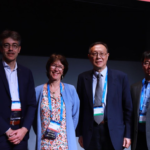
The 29th Annual Meeting of the European Hematology Association (EHA) was held from June 13 to 16, 2024, in Madrid, Spain. As the largest international conference in the field of hematology in Europe, it attracts experts and scholars from around the world each year to share and discuss innovative ideas and the latest scientific and clinical research findings in hematology. At this year's conference, a study by Dr. Fang Xu from Prof. Yue Lu's team at Beijing Lu Daopei Hospital was selected for poster presentation (P1299). The study compared the application of ATG-T vs. ATLG in TBI-based conditioning for alternative donor allogeneic hematopoietic stem cell transplantation. We invited Dr. Fang Xu to introduce the study and provide insights for clinical practice or future research.Comparison of Rabbit Anti-Human Thymocyte Globulin (ATG-T) vs. Anti-Human T Cell Rabbit Immunoglobulin (ATLG) in TBI-Based Conditioning for Alternative Donor Allogeneic Hematopoietic Stem Cell Transplantation for Acute Lymphoblastic Leukemia: A Single-Center Clinical Study
Background
In alternative donor hematopoietic stem cell transplantation (HSCT), rabbit ATG (ATG-T, Sanofi, France; ATG-F Grafalon, Neovii Biotech GmbH, Germany) is commonly used to prevent graft-versus-host disease (GVHD). This retrospective study aimed to evaluate the safety and efficacy of ATG-T and ATLG in TBI-based conditioning for HSCT in patients with acute lymphoblastic leukemia (ALL) using haploidentical (HID) or unrelated donors (MUD).
Methods
We retrospectively analyzed data from ALL patients who underwent alternative donor allogeneic HSCT with TBI-based conditioning and GVHD prevention using ATG-T or ATLG at our center from January 2018 to December 2022.
Results
Our analysis included 142 ALL patients who received HSCT from HID (n=11) or MUD (n=131). The median age was 19 years (range: 2–56 years). All patients received TBI-based conditioning (total dose 1200 cGy, 200 cGy bid for three days). Ninety-seven patients received ATLG (total dose 20 mg/kg over four days), and 45 patients received ATG-T (total dose 6.5–7.5 mg/kg over four days) for GVHD prevention. The study subjects included acute T-lymphoblastic leukemia (T-ALL, n=24) and acute B-lymphoblastic leukemia (B-ALL, n=118) patients, categorized into standard-risk (n=53) and high-risk (n=89) groups based on their diagnosis.
All patients achieved morphologic complete remission (CR) before transplantation, with 19 showing minimal residual disease (MRD) positivity and 25 having extramedullary disease. Before transplantation, 64 patients had received CAR-T therapy, and 10 were undergoing their second transplant. According to the Hematopoietic Cell Transplantation Comorbidity Index (HCT-CI), 65 patients scored 0, 62 scored 1, and 15 scored ≥2 before transplantation. The median follow-up for surviving patients was 36 months (range: 12–73 months). All patients achieved neutrophil engraftment post-transplant. The incidence of 100-day grade II-IV acute GVHD (aGVHD) was significantly lower in the ATLG group compared to the ATG-T group [26.8% (95% CI: 22.3–31.3) vs. 62.1% (95% CI: 55.9–69.3), P=0.001]. However, the incidence of grade III-IV aGVHD was similar between the two groups [9.1% (95% CI: 6.0–12.1) vs. 10.5% (95% CI: 4.3–16.7), P=0.956]. There were no significant differences in the 3-year chronic GVHD (cGVHD) [18.2% (95% CI: 14.2–22.2) vs. 27.5% (95% CI: 19.7–34.7), P=0.353] and extensive cGVHD [12.5% (95% CI: 8.2–16.8) vs. 7.2% (95% CI: 3.0–11.4), P=0.545] rates between the ATLG and ATG-T groups.
The 100-day incidence of EBV viremia was significantly lower in the ATLG group compared to the ATG-T group [11.3% (95% CI: 8.2–14.4) vs. 24.4% (95% CI: 18.0–30.8), P=0.028], as well as the 180-day incidence of post-transplant lymphoproliferative disorder (PTLD) [1% (95% CI: 0–2) vs. 11.1% (95% CI: 6.4–15.8), P=0.005] and the 360-day incidence of human parvovirus B19 viremia [25.8% (95% CI: 21.4–30.0) vs. 55.6% (95% CI: 48.2–63.0), P=0.000]. There were no significant differences in the 100-day CMV viremia [43.3% (95% CI: 38.3–48.3) vs. 60.0% (95% CI: 52.7–67.3), P=0.101], 360-day hemorrhagic cystitis [16.5% (95% CI: 12.7–20.3) vs. 15.6% (95% CI: 10.2–21.0), P=0.846], and other types of viremia [3.1% (95% CI: 1.3–4.9) vs. 2.2% (95% CI: 0–4.4), P=0.774] rates between the two groups.
In terms of long-term outcomes post-transplant, there were no significant differences between the ATLG and ATG-T groups in 5-year overall survival (OS) [81.4% (95% CI: 77.5–85.3) vs. 81.9% (95% CI: 76.1–87.7), P=0.942], 5-year leukemia-free survival (LFS) [81.4% (95% CI: 77.5–85.3) vs. 81.9% (95% CI: 76.1–87.7), P=0.942], 5-year cumulative incidence of relapse (CIR) [12.9% (95% CI: 9.4–16.4) vs. 9.3% (95% CI: 4.9–13.7), P=0.592], and transplant-related mortality (TRM) [6.5% (95% CI: 3.9–9.1) vs. 9.7% (95% CI: 5.1–12.3), P=0.578].
Conclusion
Our study indicates that using ATLG as GVHD prophylaxis in TBI-based conditioning for alternative donor HSCT in ALL patients significantly reduces the risk of 100-day grade II-IV aGVHD compared to ATG-T. Additionally, it lowers the incidence of EBV viremia, PTLD, and human parvovirus B19 viremia, while maintaining comparable post-transplant outcomes. Based on these findings, ATLG is a viable option for GVHD prevention in TBI MAC-HSCT for ALL patients using alternative donors.


